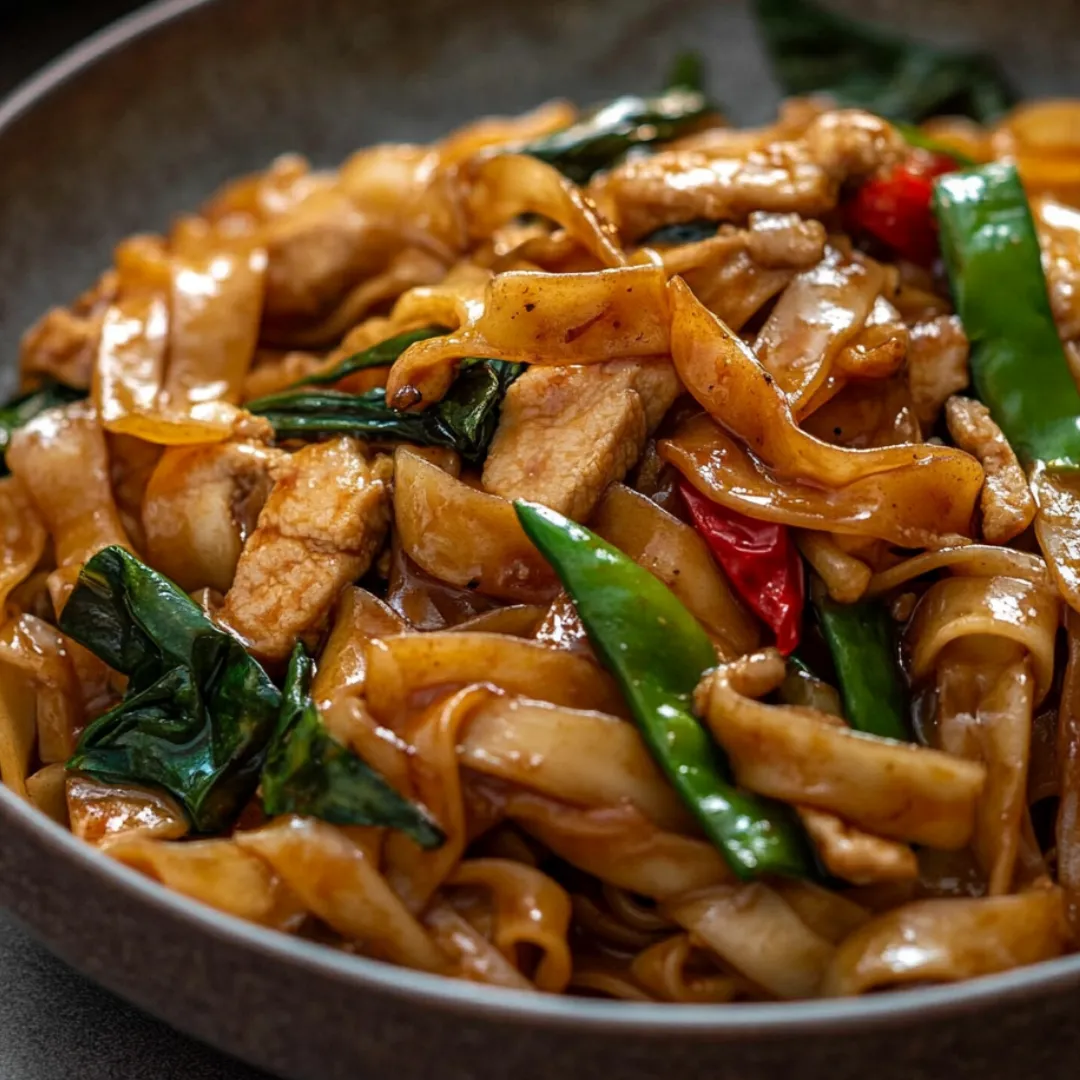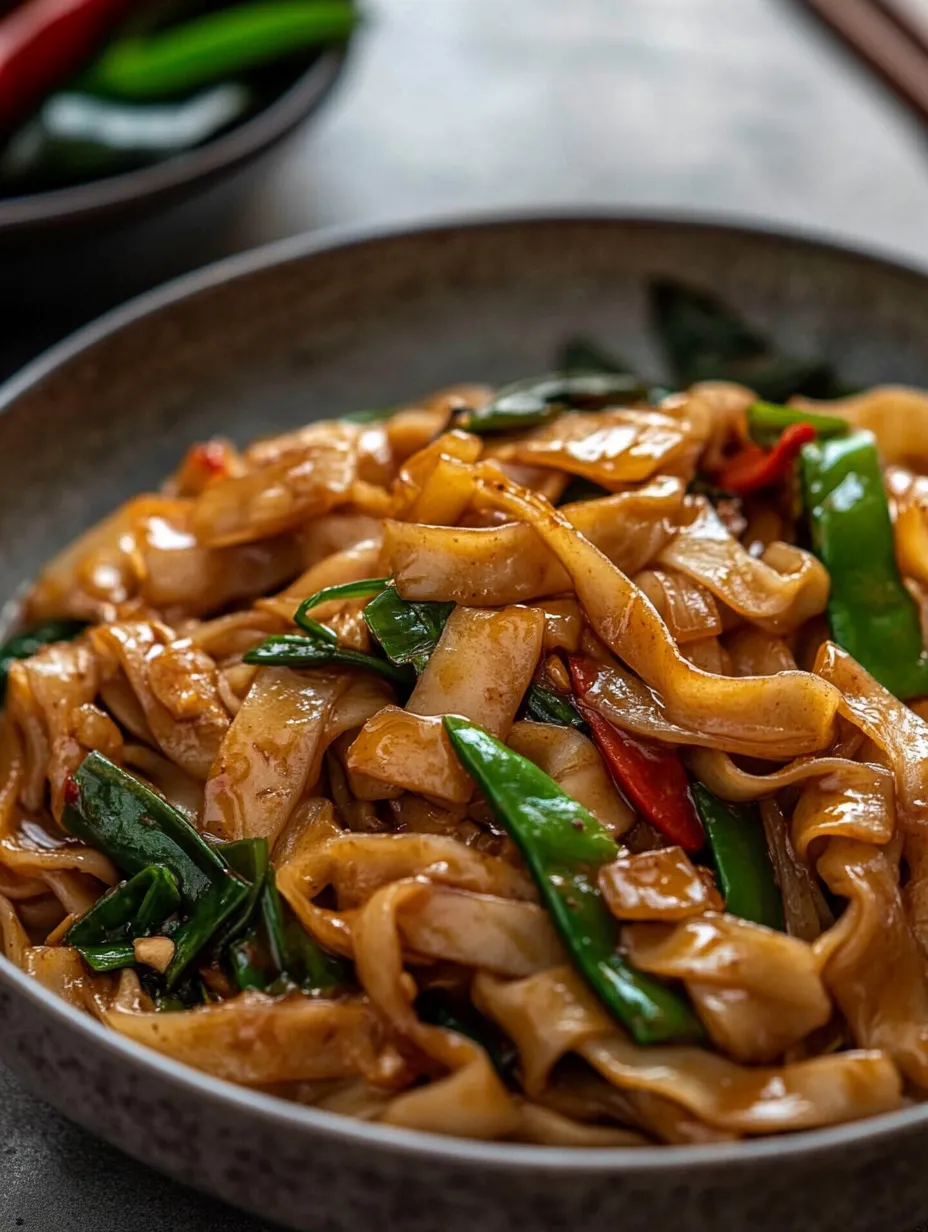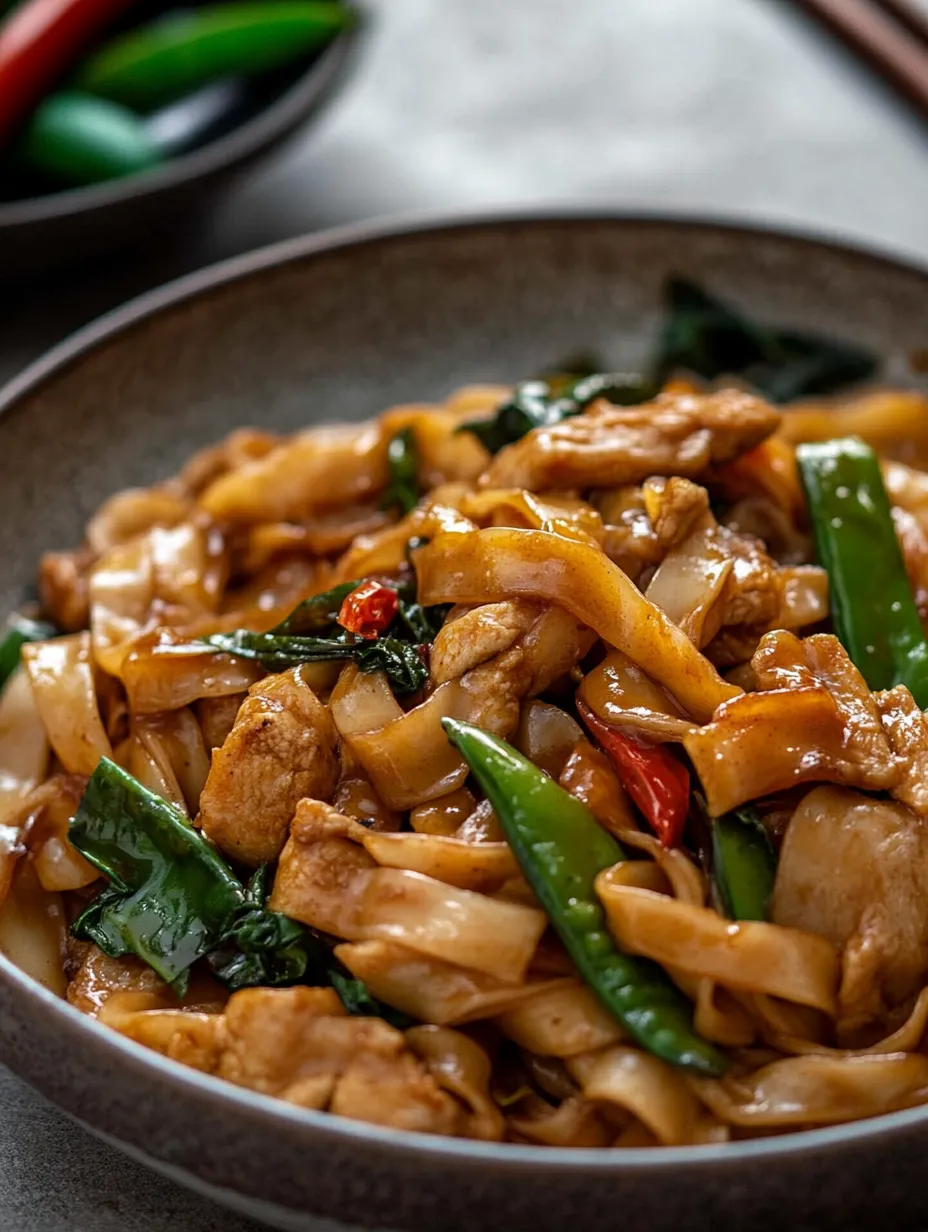 Pin it
Pin it
These Thai drunken noodles transform ordinary ingredients into something truly extraordinary with minimal effort. The magic happens when wide rice noodles meet a savory-spicy sauce that clings to every strand, creating the perfect balance of heat, umami, and subtle sweetness. Despite the name, there's no alcohol in sight – just an intoxicating combination of flavors that might leave you feeling tipsy with satisfaction. The smoky char from high-heat cooking, the aromatic Thai basil, and the punch of bird's eye chilies create a street food experience right in your kitchen. Whether you're nursing a hangover or simply craving something bold and satisfying, these noodles deliver restaurant-quality flavor that will have you pushing aside takeout menus for good.
I discovered this recipe during a culinary adventure through Thailand, where I convinced a street vendor in Bangkok to share her secrets after becoming a regular at her stall. The first time I made these noodles at home, my kitchen filled with aromas that transported me straight back to those bustling streets. What surprised me most was how the simplicity of the technique belied the complexity of flavors. Now these noodles appear regularly on our dinner table, especially when friends come over – their eyes widen at the first spicy, savory bite, followed inevitably by requests for the recipe.
Essential Ingredients
- Wide Rice Noodles (8 ounces): The foundation of the dish, these flat, chewy noodles are designed to hold sauce in their folds. Fresh ones (often labeled 'ho fun') offer superior texture, but dried wide rice noodles work beautifully too. Their neutral flavor becomes a canvas for the bold sauce. Prepare according to package directions, being careful not to overcook
- Chicken Breast (1 pound): Sliced thinly against the grain for tenderness and quick cooking. The brief marination in soy sauce not only seasons but also protects the meat during high-heat cooking. Dark meat thighs can be substituted for even more succulence
- Thai Bird's Eye Chilies (2-6): These small, fiery peppers are non-negotiable for authentic flavor. Their heat hits differently than other chilies – bright and sharp rather than lingering. Adjust quantity based on your heat tolerance, but don't eliminate completely
- Thai Basil (1 cup, loosely packed): The aromatic heart of drunken noodles with its distinctive anise-like flavor and slight peppery quality. Holy basil is traditional but rare outside Thailand; Thai basil makes an excellent substitute. Regular Italian basil lacks the essential flavor notes and should be a last resort
- Fish Sauce (2 tablespoons): The umami foundation of the sauce. Don't be deterred by its aroma – it transforms completely when cooked, providing that elusive depth that defines Thai cuisine
- Dark Soy Sauce (1 tablespoon): Contributes both color and a subtle sweetness. This thicker, darker version of soy sauce gives the noodles their characteristic rich hue
- Oyster Sauce (2 tablespoons): Adds body and complex umami notes to the sauce. Its slight sweetness helps balance the saltiness of the fish sauce
- Brown Sugar (1 tablespoon): Balances the salty and spicy elements. The subtle molasses notes in brown sugar complement the dish better than white sugar
- Garlic (4-5 cloves): Provides aromatic foundation. Rough chopping rather than mincing prevents burning during high-heat cooking
- Shallots (2 medium): Offer a sweeter, more delicate flavor than regular onions. Slice thinly to allow for quick cooking
- Green Onions (3 stalks): Adds fresh, mild onion flavor and color contrast. Separate white parts (cooked with aromatics) from green parts (added at the end)
- Vegetables: Bok choy, Chinese broccoli, or other quick-cooking greens add nutrition and color. Slice thinly to ensure they cook at the same rate as the other ingredients
 Pin it
Pin it
Step-by-Step Cooking Instructions
- Prepare the Noodles:
- Begin by cooking your rice noodles according to package instructions, but aim for slightly undercooked (very al dente) as they'll finish cooking in the wok. For dried wide rice noodles, this typically means soaking in hot water for 15-20 minutes until pliable but still firm. Drain thoroughly and toss with a teaspoon of neutral oil to prevent sticking. This preparation step is crucial – properly cooked noodles maintain their integrity during stir-frying rather than breaking apart or turning mushy.
- Create the Stir-Fry Sauce:
- In a small bowl, combine 2 tablespoons fish sauce, 1 tablespoon dark soy sauce, 2 tablespoons oyster sauce, 1 tablespoon brown sugar, and 1 tablespoon water. Whisk until the sugar dissolves completely. This balanced sauce combines salty, sweet, and umami elements that will coat the noodles perfectly. Having it premixed ensures even distribution of flavors and prevents the common mistake of over-seasoning during the high-heat cooking phase.
- Prepare and Marinate the Chicken:
- Slice 1 pound of boneless chicken breast against the grain into thin strips, about ⅛-inch thick. Cutting against the grain shortens the muscle fibers, ensuring tender meat even with quick cooking. Place the chicken strips in a bowl and add 1 tablespoon of regular soy sauce and a pinch of black pepper. Mix well and let marinate for at least 15 minutes while you prepare the other ingredients. This brief marination seasons the meat throughout and helps it retain moisture during the intense heat of stir-frying.
- Organize Your Mise en Place:
- Before heating your wok, have everything prepped and arranged in order of use: thinly sliced shallots, chopped garlic, sliced bird's eye chilies (seeds removed for less heat if desired), chopped vegetables, prepared noodles, stir-fry sauce, and roughly torn Thai basil leaves. Drunken noodles cook extremely quickly, so organization is essential for success. Professionals call this 'mise en place' – everything in its place – and it's particularly critical for high-heat wok cooking where there's no time to search for ingredients once you've started.
- Sear the Chicken:
- Heat a wok or large skillet over high heat until it's smoking slightly. Add 1 tablespoon of neutral oil with a high smoke point (such as peanut or canola). Swirl to coat the cooking surface, then add the marinated chicken in a single layer. Let it sear undisturbed for about 1 minute to develop some color, then stir-fry for another 1-2 minutes until just cooked through but still tender. Remove the chicken to a clean plate, leaving any flavorful oils in the wok.
- Build the Aromatic Base:
- Return the wok to high heat and add another tablespoon of oil if needed. Add the sliced shallots, white parts of green onions, and garlic. Stir-fry for about 30 seconds until fragrant but not browned. Add the sliced chilies and continue stir-frying for another 15-20 seconds. The aromatics should sizzle vigorously and become fragrant without burning. This step creates the foundation of flavor that will permeate the entire dish.
- Cook the Vegetables:
- Add your chosen vegetables to the wok and stir-fry for 1-2 minutes, depending on their density. Bok choy will wilt quickly, while firmer vegetables like Chinese broccoli may need a bit longer. The goal is tender-crisp vegetables that retain their vibrant color and some texture. High heat and constant motion are key – you want to quickly sear the vegetables rather than steam them.
- Combine and Finish:
- Return the cooked chicken to the wok along with the prepared noodles. Pour the stir-fry sauce around the edges of the wok (this helps it reduce quickly) and toss everything together using a scooping motion from the bottom of the wok. Continue stir-frying for about 1-2 minutes until the noodles absorb the sauce and develop some charred edges. Add the Thai basil leaves and green parts of the green onions, tossing for just 30 seconds until the basil wilts but still retains its color and aroma. The finished noodles should have a glossy appearance with visible caramelization on some edges.
- Serve Immediately:
- Transfer to a large serving platter or individual bowls and serve piping hot. Drunken noodles are at their peak when freshly made, with the perfect balance of textures and the aromatic basil still bright and vibrant. Offer additional condiments on the side if desired – Thai chili vinegar, fish sauce with sliced chilies, or crushed peanuts – allowing diners to adjust flavors to their preference.
My first experience with truly authentic drunken noodles came after a long night in Bangkok, when a friend guided me to a tiny street vendor known for serving the city's best hangover cure. The vendor laughed at my sweaty reaction to the heat but nodded approvingly as I continued eating, unable to stop despite the building spice. She later told me the secret was cooking in small batches at extremely high heat – a technique I've tried to replicate ever since. At home, I've found that using my heaviest cast iron skillet gets me closest to that authentic street food flavor when a traditional wok and high-BTU burner aren't available.
Adapting Heat Levels for Different Palates
While authenticity is admirable, the traditional fire-breathing spice level of drunken noodles isn't for everyone. Fortunately, this dish allows for heat adjustments without sacrificing its essential character. For milder versions, remove the seeds and membranes from the bird's eye chilies before slicing – this reduces heat while maintaining their unique flavor. Another approach is to use two types of chilies: keep one or two bird's eye chilies for authentic flavor and add milder peppers like Korean gochugaru or even bell peppers for color and sweetness. If serving guests with varying spice tolerances, consider preparing the base dish milder and offering fresh sliced chilies or chili oil on the side for heat-seekers to customize their portions. What's non-negotiable is including at least some chili heat – without it, you're making a different dish entirely, as the interaction between spice and the aromatic basil creates the signature flavor profile.
The Importance of Proper Noodle Technique
The success of drunken noodles hinges significantly on your noodle preparation. Fresh wide rice noodles (found in the refrigerated section of Asian markets) provide the most authentic texture, but require gentle handling – separate them carefully and never refrigerate after purchasing as they become brittle. If using dried noodles, avoid the common mistake of fully cooking them before stir-frying. Instead, undercook them slightly – they should be pliable but still have a firm bite, as they'll continue cooking in the wok. After draining, immediately rinse with cool water to stop the cooking process and remove excess starch, then toss with a small amount of oil to prevent sticking. When adding noodles to the wok, use a lifted tossing motion rather than stirring, which can break the delicate strands. This gentle separation technique keeps the noodles intact while allowing the sauce to coat each piece evenly for the perfect final texture.
Creating That Elusive Restaurant Flavor
The distinctive smoky flavor of restaurant-quality drunken noodles comes from 'wok hei' – literally the 'breath of the wok.' This elusive quality develops when ingredients are cooked at extremely high temperatures in a well-seasoned wok, creating complex flavor compounds through caramelization and slight charring. While home stoves rarely reach the 100,000+ BTU heat of commercial wok burners, you can approximate this effect with a few techniques. First, heat your wok or heavy skillet until it's smoking before adding oil. Cook in smaller batches to maintain temperature – overcrowding the pan causes steaming instead of searing. Allow ingredients to rest against the hot sides of the wok briefly before tossing. Finally, don't stir constantly; giving ingredients a moment of undisturbed contact with the hot surface develops those desirable charred edges. These techniques help create that distinctive restaurant flavor that distinguishes great noodles from merely good ones.
Perfect Protein Pairings
While this recipe features chicken, drunken noodles welcome a variety of proteins that can be substituted based on preference or what's available in your kitchen. Thinly sliced beef (particularly flank steak) stands up well to the bold flavors – marinate it briefly with a splash of fish sauce and cornstarch for tenderness. Jumbo shrimp offer sweet contrast to the spicy sauce and cook even more quickly than chicken – add them later in the process to prevent overcooking. For plant-based versions, extra-firm tofu presses and marinates beautifully, though you'll want to fry it separately first for the best texture. My personal favorite variation uses thinly sliced pork belly, which renders its fat into the dish as it cooks, creating an even richer sauce that clings magnificently to the noodles. The versatility of the base recipe makes it an excellent template for using whatever protein looks freshest at the market that day.
 Pin it
Pin it
Make-Ahead and Storage Strategies
Surprisingly for such a quick-cooking dish, drunken noodles lend themselves well to meal planning with a few adjustments. For make-ahead preparation, complete all the chopping and slicing of aromatics and proteins up to two days in advance, storing them separately in the refrigerator. The stir-fry sauce can be mixed and refrigerated for up to a week, allowing its flavors to meld even more deeply. For leftover storage, these noodles maintain their quality better than many other stir-fries – the rich sauce prevents them from drying out during reheating. Store in airtight containers for up to four days, adding a teaspoon of water when reheating to revive the sauce. Unlike many noodle dishes, these actually freeze reasonably well for up to a month – thaw overnight in the refrigerator and reheat in a hot skillet rather than microwave for the best texture restoration.
After years of trying to recreate that perfect plate of drunken noodles from the streets of Bangkok, I've come to appreciate that the beauty of this dish lies in its bold simplicity. While the ingredient list might look long, the cooking process happens in a flash, creating complex flavors through technique rather than complicated components. There's something deeply satisfying about the way the aromatic Thai basil perfumes the entire kitchen, signaling that dinner is moments away. Whether I'm cooking for family on a busy weeknight or serving friends who've never experienced authentic Thai street food, these noodles never fail to transport us all to those vibrant Bangkok streets – no passport required, just a good hot wok and a willingness to embrace the heat.
Frequently Asked Questions
- → What makes these noodles "drunken"?
- Despite the name, there's no alcohol in the dish. Some say it was created as a late-night meal after drinking, while others believe the name comes from the drunken wobbliness of the wide noodles. Another theory suggests the spiciness makes you feel intoxicated.
- → Can I substitute the holy basil with something else?
- Holy basil (Thai basil) has a distinct flavor that's ideal for this dish. If unavailable, regular Italian basil can work as a substitute, though the flavor profile will be different. Sweet basil has a more pronounced anise flavor, while holy basil is more peppery.
- → How can I make this dish vegetarian/vegan?
- Replace chicken with firm tofu or seitan, and use mushroom sauce instead of oyster sauce. Substitute vegetable broth for chicken stock and use a vegetarian fish sauce alternative (made from seaweed) or more soy sauce with a splash of lime juice.
- → What if I can't handle spicy food?
- You can reduce or omit the Thai chili peppers. The dish will still be flavorful from the aromatics and sauce components. For a very mild version, use a small amount of bell pepper for color instead of chili peppers.
- → Can I add other vegetables to this dish?
- Yes, bell peppers, carrots, mushrooms, or baby corn work well. Add harder vegetables earlier in the cooking process and quick-cooking ones later. Mushrooms should be sautéed separately first to release their moisture before adding to the main dish.
